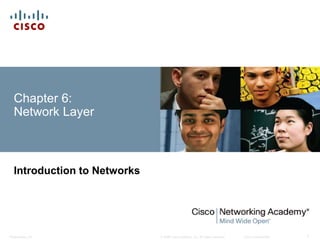The document discusses network layer protocols and routing. It describes how network layer protocols like IPv4 and IPv6 support communication across networks by addressing devices, encapsulating data, and routing packets. It also explains how routers use routing tables to determine the paths that network traffic should take to reach different destinations and enable connectivity in a network.



























![Presentation_ID 28© 2008 Cisco Systems, Inc. All rights reserved. Cisco Confidential
Router Routing Tables
IPv4 Router Routing Table
R1#show ip route
Codes: L - local, C - connected, S - static, R - RIP, M - mobile, B - BGP
D - EIGRP, EX - EIGRP external, O - OSPF, IA - OSPF inter area
N1 - OSPF NSSA external type 1, N2 - OSPF NSSA external type 2
E1 - OSPF external type 1, E2 - OSPF external type 2, E - EGP
i - IS-IS, L1 - IS-IS level-1, L2 - IS-IS level-2, ia - IS-IS inter area
* - candidate default, U - per-user static route, o - ODR
P - periodic downloaded static route
Gateway of last resort is not set
10.0.0.0/8 is variably subnetted, 2 subnets, 2 masks
D 10.1.1.0/24 [90/2170112] via 209.165.200.226, 00:00:05, Serial0/0/0
D 10.1.2.0/24 [90/2170112] via 209.165.200.226, 00:00:05, Serial0/0/0
192.168.10.0/24 is variably subnetted, 2 subnets, 3 masks
C 192.168.10.0/24 is directly connected, GigabitEthernet0/0
L 192.168.10.1/32 is directly connected, GigabitEthernet0/0
192.168.11.0/24 is variably subnetted, 2 subnets, 3 masks
C 192.168.11.0/24 is directly connected, GigabitEthernet0/1
L 192.168.11.1/32 is directly connected, GigabitEthernet0/1
209.165.200.0/24 is variably subnetted, 2 subnets, 3 masks
C 209.165.200.224/30 is directly connected, Serial0/0/0
L 209.165.200.225/32 is directly connected, Serial0/0/0
R1#
192.168.10.0/24
R2
192.168.11.0/24
10.1.1.0/24
10.1.2.0/24
209.165.200.224 /30
.226
.10
.10
.10
.10
.1
.1.1
G0/1
.225
S0/0/0
G0/0
.1
R1
PC1
PC2](https://image.slidesharecdn.com/ccnav5semester1chapter6-161225124506/85/Ccna-v5-S1-Chapter-6-28-320.jpg)

![Presentation_ID 30© 2008 Cisco Systems, Inc. All rights reserved. Cisco Confidential
Router Routing Tables
Remote Network Routing Table Entries
D 10.1.1.0/24 [90/2170112] via 209.165.200.226, 00:00:05, Serial0/0/0
A Identifies how the network was learned by the router.
B Identifies the destination network.
C Identifies the administrative distance (trustworthiness) of the route source.
D Identifies the metric to reach the remote network.
E Identifies the next hop IP address to reach the remote network.
F Identifies the amount of elapsed time since the network was discovered.
G Identifies the outgoing interface on the router to reach the destination network.
192.168.10.0/24
R2
192.168.11.0/24
10.1.1.0/24
10.1.2.0/24
209.165.200.224 /30
.226
.10
.10
.10
.10
.1
.1
64.100.0.1
.1
G0/1
.225
S0/0/0
G0/0
.1
R1
PC1
PC2](https://image.slidesharecdn.com/ccnav5semester1chapter6-161225124506/85/Ccna-v5-S1-Chapter-6-30-320.jpg)
![Presentation_ID 31© 2008 Cisco Systems, Inc. All rights reserved. Cisco Confidential
Router Routing Tables
Next-Hop Address
192.168.10.0/24
R2
192.168.11.0/24
10.1.1.0/24
10.1.2.0/24
209.165.200.224 /30
.226
.10
.10
.10
.10
.1
.1
64.100.0.1
.1
G0/1
.225
S0/0/0
G0/0
.1
R1
PC1
PC2
R1#show ip route
Codes: L - local, C - connected, S - static, R - RIP, M - mobile, B - BGP
D - EIGRP, EX - EIGRP external, O - OSPF, IA - OSPF inter area
N1 - OSPF NSSA external type 1, N2 - OSPF NSSA external type 2
E1 - OSPF external type 1, E2 - OSPF external type 2, E - EGP
i - IS-IS, L1 - IS-IS level-1, L2 - IS-IS level-2, ia - IS-IS inter area
* - candidate default, U - per-user static route, o - ODR
P - periodic downloaded static route
Gateway of last resort is not set
10.0.0.0/8 is variably subnetted, 2 subnets, 2 masks
D 10.1.1.0/24 [90/2170112] via 209.165.200.226, 00:00:05, Serial0/0/0
D 10.1.2.0/24 [90/2170112] via 209.165.200.226, 00:00:05, Serial0/0/0
192.168.10.0/24 is variably subnetted, 2 subnets, 3 masks
C 192.168.10.0/24 is directly connected, GigabitEthernet0/0
L 192.168.10.1/32 is directly connected, GigabitEthernet0/0
192.168.11.0/24 is variably subnetted, 2 subnets, 3 masks
C 192.168.11.0/24 is directly connected, GigabitEthernet0/1
L 192.168.11.1/32 is directly connected, GigabitEthernet0/1
209.165.200.0/24 is variably subnetted, 2 subnets, 3 masks
C 209.165.200.224/30 is directly connected, Serial0/0/0
L 209.165.200.225/32 is directly connected, Serial0/0/0
R1#](https://image.slidesharecdn.com/ccnav5semester1chapter6-161225124506/85/Ccna-v5-S1-Chapter-6-31-320.jpg)













![Presentation_ID 45© 2008 Cisco Systems, Inc. All rights reserved. Cisco Confidential
Configure Initial Settings
Router Configuration Steps
Router> enable
Router# configure terminal
Enter configuration commands, one per line.
End with CNTL/Z.
Router(config)# hostname R1
R1(config)#
192.168.10.0/24
R2
192.168.11.0/24
10.1.1.0/24
10.1.2.0/24
209.165.200.224 /30
.226
.10
.10
.10
.10
.1
.1.1
G0/1
.225
S0/0/0
G0/0
.1
R1
PC1
PC2
Router> en
Router# conf t
Enter configuration commands, one per line.
End with CNTL/Z.
Router(config)# ho R1
R2(config)#
OR
R1(config)# enable secret class
R1(config)#
R1(config)# line console 0
R1(config-line)# password cisco
R1(config-line)# login
R1(config-line)# exit
R1(config)#
R1(config)# line vty 0 4
R1(config-line)# password cisco
R1(config-line)# login
R1(config-line)# exit
R1(config)#
R1(config)# service password-encryption
R1(config)#
R1(config)# banner motd #
Enter TEXT message. End with the character '#'.
***********************************************
WARNING: Unauthorized access is prohibited!
***********************************************
#
R1(config)#
R1# copy running-config startup-config
Destination filename [startup-config]?
Building configuration...
[OK]
R1#](https://image.slidesharecdn.com/ccnav5semester1chapter6-161225124506/85/Ccna-v5-S1-Chapter-6-45-320.jpg)








